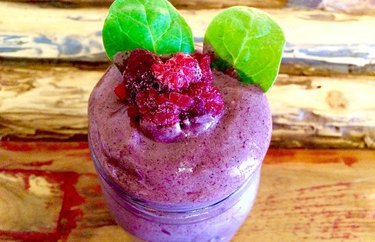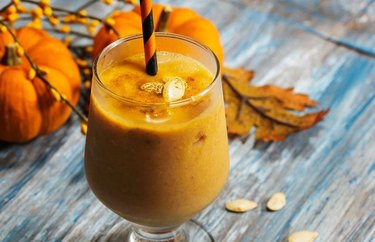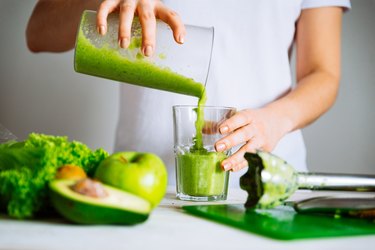
The perfect smoothie is both delicious and healthy. But before you pull out your blender and start whizzing up your staple smoothie concoction, you'll want to better understand those common smoothie slip-ups that can mess up your diet, or even lead to weight gain.
Read on to understand some potential smoothie-making pitfalls, and then find some of our favorite, dietitian-approved recipes to inspire your next blending adventure.
Video of the Day
Video of the Day
The Health Benefits of Smoothies
Smoothies are a useful way to get more fruit and vegetables in your diet (other than, well, eating them), according to Harvard Health Publishing. Unlike juices, they're usually made from whole fruit and vegetables, so they're higher in fiber and lower on the glycemic index. This means less blood sugar highs and lows, which can help control cravings.
Smoothies are easy to make and portable enough to grab when you're out and about and on the go. They're useful for those days when you have no time for breakfast or have just finished a workout and need a quick refuel.
If you're not a fan of leafy greens but know your diet could use more, try blending them into a fruit smoothie for an easy win. The fruit in your smoothie will offset that of the bitter greens — but keep in mind that plenty of vegetables can be sweet, too.
"My fave veggies for smoothies are spinach, any greens, frozen cauliflower or frozen broccoli. You can't really taste them!" says Isabel Smith, RD, CDN, a registered dietitian based in New York City.
5 Common Smoothie Mistakes (and Their Fixes)
Smoothies can be part of a healthy diet that supports your weight-loss goals — as long as you don't fall prey to these common smoothie mistakes.
1. Drinking Too Many Calories
Although the mechanism isn't fully understood, scientists believe that we are more likely to over-consume calories if we drink rather than eat them.
"Liquid calories don't register in your body the way that solid calories do," says Jennifer Koslo, RDN, dietitian, certified personal trainer and author of Healthy Smoothie Recipe Book: Easy Mix-and-Match Smoothie Recipes for a Healthier You. "So you can drink a smoothie and, depending on how thick it is, feel hungry soon after."
A much-cited August 2004 study in JAMA found that women who consumed sugar-sweetened beverages put on more weight than those who didn't. Researchers attribute this to the fact that drinks can contain a lot of sugars, yet the body cannot recognize and adjust intake to compensate, as it does when you are full after a solid meal.
The fix: Don't go overboard with smoothies, keep an eye on the number of calories they contain and consider switching things up with a smoothie bowl. The thicker texture helps your body know that it's full.
If you're using it as a meal replacement, a smoothie should contain about 300 to 450 calories, Smith says. Stick to 100 to 250 calories for a snack.
Related Reading
2. Adding Too Much Fruit
"The biggest mistake I see is that people just mix a ton of fruit with fruit juice and blend. That equals a nap for me — hello, sugar crash, " Smith says.
Keep in mind that a large, fruit-only smoothie can have over 500 calories.
The fix: Skip fruit juice, since it only adds calories and isn't needed if you're using whole fruit. Use water, dairy milk or a milk alternative as your base instead, Koslo says.
When it comes to whole fruit, Smith recommends adding no more than 1/2 to 3/4 cup of fruit per serving, and rounding out the drink with other ingredients.
3. Forgoing Filling Protein, Fiber or Fat
"If you want smoothies to be satisfying and help with weight loss, then there needs to be a balance of slow-digesting carbohydrates, some sort of protein and then some healthy fat and fiber," Koslo says.
Why? "Protein and fat help to keep us feeling full and they slow digestion," Smith says. "Liquids digest more quickly than solids do, so adding some extra fat and protein can help to slow this process down and keep us fuller for longer."
Adding extra protein to your diet may even help you lose weight. Although a small sample size, a February 2015 study in the journal Nutrition found that women who ate a high-protein breakfast felt fuller and ate less at lunchtime, compared to those who ate a low-protein breakfast or none at all. Plus, a December 2019 meta-analysis in Advances in Nutrition found that people who actively cut calories to lose weight should eat more protein than the average person.
The fix: Aim for 17 to 25 grams of protein per smoothie if you are using one as a meal replacement, 10 to 12 grams for a snack, Smith says.
Good protein choices include Greek yogurt, cottage cheese or white beans and peas. Or choose from one of the many dairy- or plant-based protein powders now available.
For fiber, try ground flaxseed, a tablespoon of nuts or some soaked oats. For fats, good options include a third of an avocado or one tablespoon of coconut oil or nut butter.
4. Adding Sweeteners
Many recipes or bottled smoothies include added sweeteners like honey or agave, which only increase the sugar and calorie content without the benefit of extra nutrients.
The fix: The right recipe should be sweet enough! Call on the natural sugars in fruit when you're making a smoothie at home and skip the other sweeteners (yes, even the "natural"-sounding ones). Beyond sweetness, adding fruit offers the benefit of filling fiber and other nutrients. When buying bottled smoothies, check the ingredients to make sure there are no added sweeteners.
5. Drinking Smoothies With Meals
If you want to drink a smoothie alongside a meal, you'll want to lower the calorie content of the meal to compensate. Otherwise, you'll end up consuming much more than you think.
The fix: The best way to enjoy smoothies is as a breakfast replacement or snack, not with a meal. "A lower-calorie smoothie as an afternoon snack would be good, instead of reaching for empty carbs like pretzels or candy," Koslo says.
Related Reading
5 Healthy Smoothie Recipes to Try
1. Everyday Green Smoothie
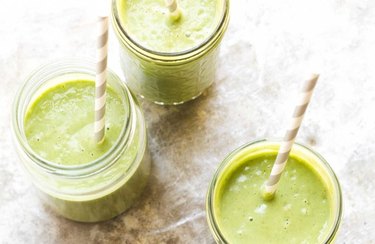
This one isn't too sweet (no sugar bomb here). Plus, it's balanced with plant-based protein and a healthy dose of greens for good measure.
Get the Everyday Green Smoothie recipe and nutrition info here.
Spinach is a favorite for smoothies because its texture and taste are so much easier to hide than kale, and it allows the bright flavors of your raw fruits to shine through. This recipe uses steamed spinach because it's easier to digest.
Get the Hidden Spinach Smoothie recipe and nutrition info here.
3. Bunny Food Smoothie
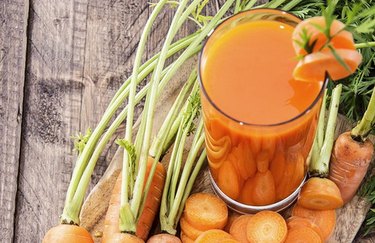
The tofu, veggies and fruit in this smoothie might sound like an unusual combination, but the subtle sweetness from the fruit and creaminess from the tofu makes this a delicious, protein-packed morning option.
Get the Bunny Food Smoothie recipe and nutrition info here.
4. Pumpkin Spice Smoothie
Push the sugary pumpkin spice latte aside and enjoy the pure taste of pumpkin in this beautifully spiced, warm smoothie that's packed with vitamins, fiber and heart-healthy fat.
Get the Pumpkin Spice Smoothie recipe and nutrition info here.
5. Paradise Smoothie
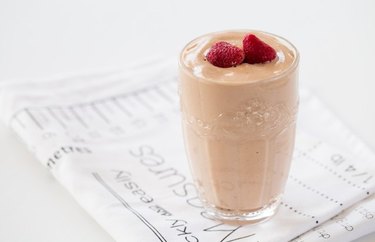
A nutrient-dense smoothie, this drink offers a punch of antioxidants, protein, vitamin C and healthy fats. Koslo recommends swapping the grapeseed oil for flax oil in this recipe.
Get the Paradise Smoothie recipe and nutrition info here.
- Harvard Health Publishing: "Drink your fruits and vegetables?"
- Journal of the American Medical Association: "Sugar-Sweetened Beverages, Weight Gain, and Incidence of Type 2 Diabetes in Young and Middle-Aged Women"
- Current Opinion in Clinical Nutrition and Metabolic Care: "Effects of carbohydrates on satiety: differences between liquid and solid food"
- Nutrition Journal: "A randomized, controlled, crossover trial to assess the acute appetitive and metabolic effects of sausage and egg-based convenience breakfast meals in overweight premenopausal women."
- Harvard T. H. Chan School of Public Health: "Healthy Beverage Guidelines."
- Advances in Nutrition: "Protein Intake Greater than the RDA Differentially Influences Whole-Body Lean Mass Responses to Purposeful Catabolic and Anabolic Stressors: A Systematic Review and Meta-analysis"
